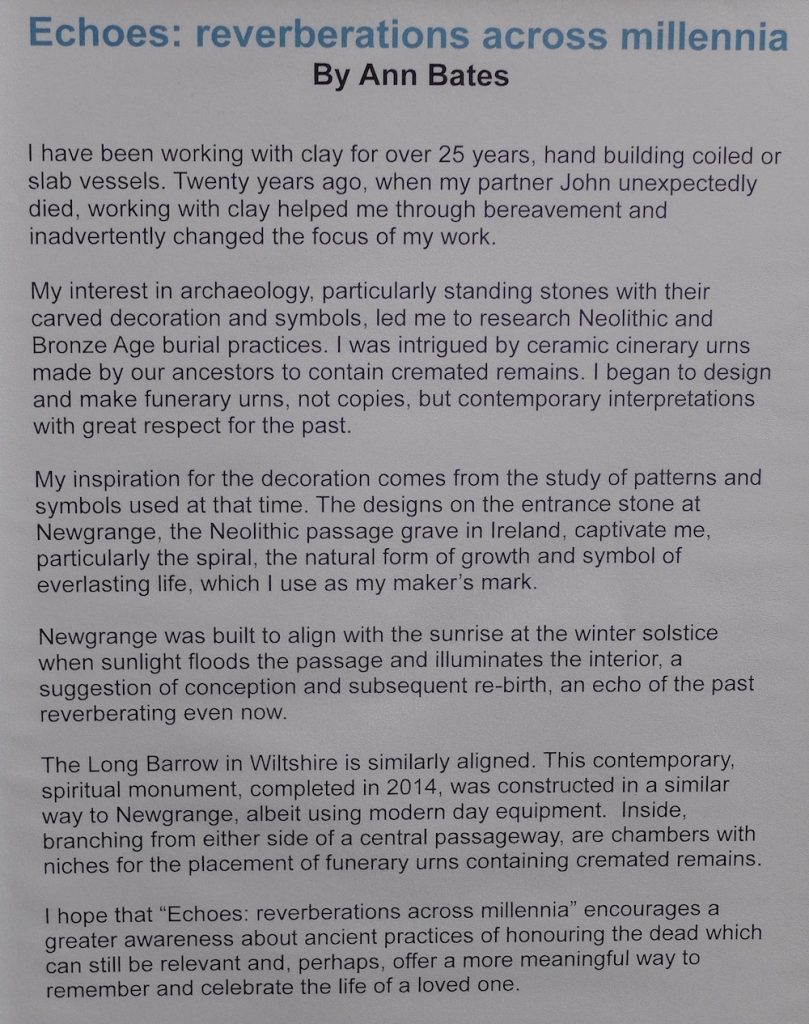Some time ago I wrote about my family’s experience of commissioning a funerary urn for my father’s ashes. We had asked Ann Bates, a potter based in Derbyshire, to make the urn with input from us on shapes and colours and designs. The urn now sits in a special place in the garden.

Ann contacted me recently to invite me to the opening of an exhibition in Buxton Museum of her work and of some of the things that inspire her designs. I was delighted to accept and I drove down to Buxton this weekend. The exhibition “Echoes: reverberations across millennia” showcases some of Ann’s work. It also looks at the neolithic and bronze age inspirations for her designs. There are some bronze age urns found locally in Derbyshire as well as photographs of the 5,200 year old passage tomb at Newgrange in Ireland. These highlight characteristic spiral designs that Ann has used and adapted extensively in her own work – including on my father’s urn.
But there are also photos of the Long Barrow at All Cannings in Wiltshire. This is a new (or “novolithic”) burial place, which was built in 2014 in the style of a traditional long barrow made relevant for today. It is has internal chambers with niches and is used as a columbarium or place for cremated remains in urns to be kept.
I’m very interested in these examples of continuity in ceremony and practice across the centuries. Here in Dundee we have a new cemetery at Pitkerro Grove. It lies just outside the city and I always like conducting funerals there as it commands fine views over the Tay and of Dundee itself. But what makes it special for me is the knowledge that when it was being constructed, much older burial sites were discovered, dating back to the early Christian period of 530-635. Evidence that this place had been used for burials for centuries and perhaps millennia.
I really enjoyed seeing the examples of Ann’s ceramics. But the highlights for me were the images illustrating the making of two pieces – the creative process itself. And one of those was my father’s urn. It was very moving to see it come together. So I have made my own little slideshow (see below) of photos from the exhibition to thank Ann for her invitation and perhaps to encourage others to think creatively about what can be done with a person’s ashes after cremation.
Michael Hannah, July 2022
The exhibition “Echoes: reverberations across millennia” is at Buxton Museum and Art Gallery until 8 October 2022.


Anne’s work is very beautiful in its own right, but the historical reverberations seem to imbue it with great serenity. I too am interested in ancient ‘life’ symbols, particularly Hopi Indian symbols of emergence which the spirals are very similar to.
I am travelling down to Derbyshire later in the summer and will definitely make some extra time to go to this exhibition – thank you for sharing.
Beautiful and timeless work by Ann Bates. Spirals, waves, and I also love the idea of the constellation on the *inside* of the urn for your father. Thank you for sharing this Michael. Indeed I hope it encourages ways of thinking creatively about what can be done with ashes after cremation.
Thanks for sharing this Michael.
You communicate the peacefulness of the exhibition as well as the intent and beauty of Ann Bates’ ceramics.
Wonderful too to see the thought, creativity and care behind the urn for your father. A splendid piece. I especially like that the constellation can only be observed if you were to handle the urn; to lift up its solid heft and look to the underside.
Carrie – I had included the idea of a star chart in the brief but initially it seemed like it might make the piece too “busy”. It was Ann who suggested that it go on the inside of the lid, which we thought was a wonderful idea. Of course, now that it’s sealed it can no longer be seen by anyone but I like that idea of a hidden detail.